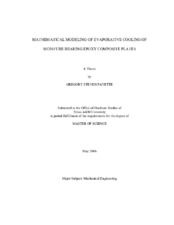| dc.description.abstract | Research is performed to assess the potential of surface moisture evaporative
cooling from composite plates as a means of reducing the external temperature of
military aircraft. To assess the feasibility of evaporative cooling for this application, a
simplified theoretical model of the phenomenon is formulated. The model consists of a
flat composite plate at an initial uniform temperature, T0. The plate also possesses an
initial moisture (molecular water) content, M0. The plate is oriented vertically and at t=0
s, one surface is exposed to a free stream of air at an elevated temperature. The other
surface is exposed to stagnant air at the same temperature as the plateÂ’s initial
temperature.
The equations associated with energy and mass transport for the model are
developed from the conservation laws per the continuum mechanics hypothesis.
Constitutive equations and assumptions are introduced to express the two nonlinear
partial differential equations in terms of the temperature, T, and the partial density of
molecular water, ρw. These equations are approximated using a weak form Galerkin
finite element formulation and the α–family of time approximation. An algorithm and accompanying computer program written in the Matlab programming language are
presented for solving the nonlinear algebraic equations at successive time steps. The
Matlab program is used to generate results for plates possessing a variety of initial
moisture concentrations, M0, and diffusion coefficients, D.
Surface temperature profiles, over time, of moisture bearing specimens are
compared with the temperature profiles of dry composite plates. It is evident from the
results that M0 and D affect the surface temperature of a moist plate. Surface
temperature profiles are shown to decrease with increasing M0 and/or D. In particular,
dry and moist specimens are shown to differ in final temperatures by as much as 30°C
over a 900 s interval when M0 = 30% and D is on the order of 10–8m2/s (T0 = 25°C,
h = 60 W/m2°C, T∞ = 90°C). | en |


